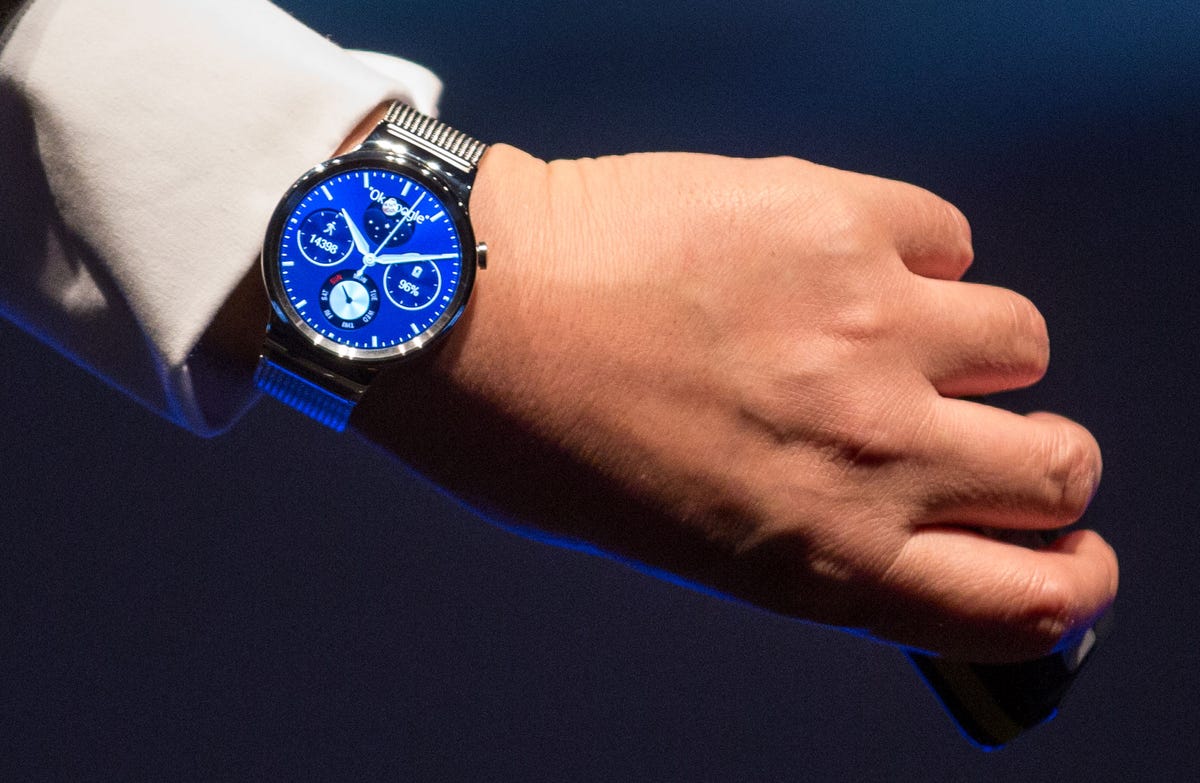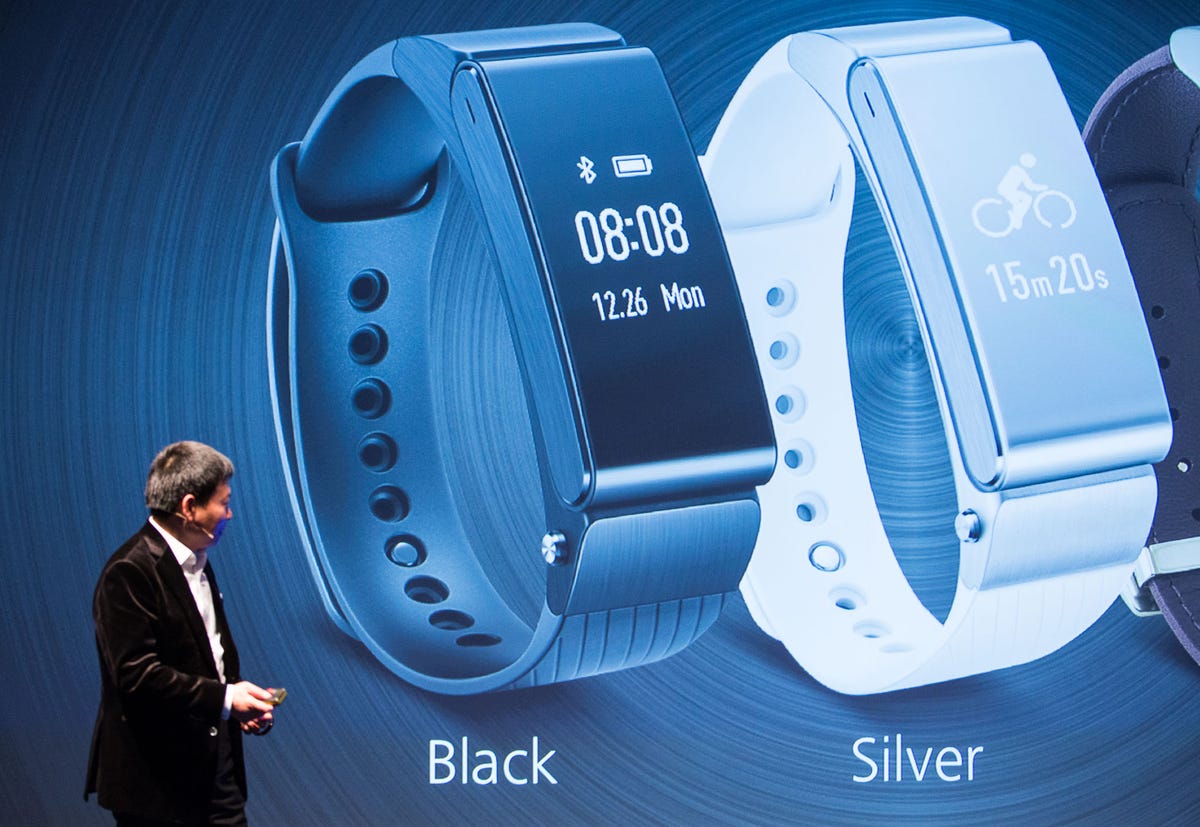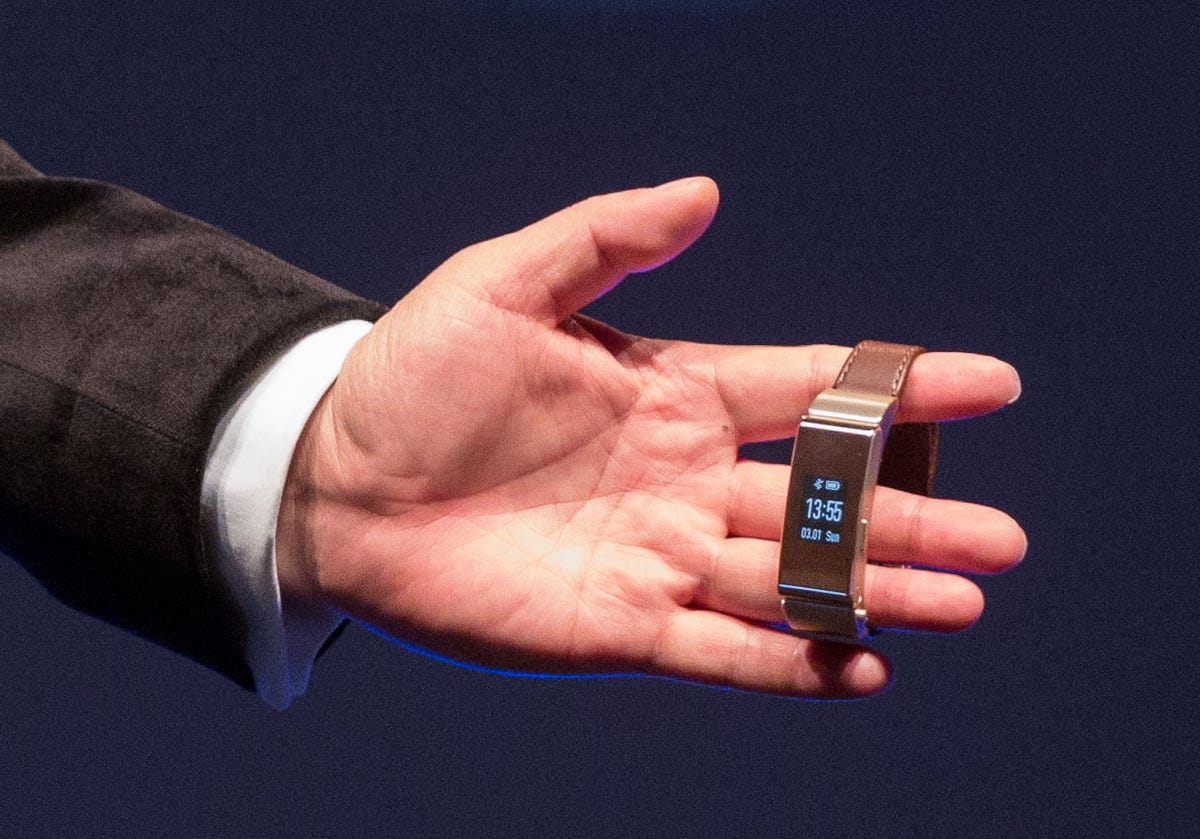
Stephen Shankland/CNET
BARCELONA — Huawei debuted its first smartwatch Sunday, upgrading its mobile device ambitions with an Android Wear-powered model designed to look as much as possible like a classical round-face timepiece.
“People prefer the traditional classical watch, but today, smartwatches are not traditional,” said Richard Yu, chief executive of Huawei’s consumer product group, in a press conference here at the Mobile World Congress show. The Huawei Watch’s 42mm circular face, stainless-steel housing, and array of 40 face looks is designed to bring more of the analog watch feel to the digital smartwatch world.
The Huawei Watch will arrive in mid-2015, perhaps in June, Yu said, but he didn’t reveal a price. The company is competing with established Android smartwatch players including Samsung, LG Electronics and Motorola. Soon it will get another competitor with a lot of clout with the arrival of the Apple Watch, which the company is expected to detail March 9.
Smartwatches have met with a lukewarm reception so far. They chiefly augment mobile phones, adding some handy features but not replacing them, and they’re hobbled by short battery life compared to regular watches.
Huawei, though, sees a big future in the watch and in two other devices it announced: the TalkBand B2 , which combines a fitness tracking band with a Bluetooth headset, and the TalkBand N1 , Bluetooth headphones that can play music, take calls and track steps. Huawei thinks such devices will eventually be built deeply into human living.
“We see that wearable devices extend the human senses, extend the human body and extend our human intelligence,” Yu said.


Stephen Shankland/CNET
Huawei Watch details
The Huawei Watch has more than 130 components and takes more than 160 steps to assemble by hand, Yu said, but he didn’t reveal details about its processor or battery life.
It supports the standard features of Google’s watch operating system — handling phone call alerts, checking email, receiving calendar prompts. That help from Google gives watches a head start in developing software but also means they’re beholden to Google for updates and have a harder time standing out from others using Android Wear.


Stephen Shankland/CNET
That means more of the device’s success hinges on hardware — both the housing and the internals.
The stainless-steel housing is stronger and more scratch-resistant than aluminum models.
Its AMOLED screen is circular with maximum width of 400×400 pixels and resolution of 286 pixels per inch. Huawei will supply 40 watch face looks for the screen, including plenty of analog-watch looks and one with a moon-phase display.
It’s also got “ergonomic button placement” for easy operation, Yu said, a durable sapphire crystal face, and a choice of interchangeable straps in different widths for men and women.
The Huawei Watch has a six-axis accelerometer, heart rate monitor and barometer for fitness-tracking functions like counting steps, logging elevation gains and calculating calories burned.
Wearable push
The TalkBand B2 is a second-generation model that’s smaller and, in Huawei’s eyes, classier than last year’s TalkBand B1. It fits into a strap where it can be used to count steps taken, but it also pops out with an extendable earbud so it can be used as a Bluetooth headset that Huawei thinks is harder to misplace than one you don’t keep on your wrist.


Stephen Shankland/CNET
It’ll be available in two versions starting in April in at least 28 countries around the world. The black or white models cost €169, and a gold-toned premium model costs €199. That’s the equivalent of $189 / £122 / AUS$242 and $223 / £144 / AUS$285.
Compared to the B1, the B2 has better noise cancellation, Yu said. It’s also 20 percent thinner at 11.5mm and 10 percent shorter, with a 62mm length. The premium model comes with an allergy-resistant band or a more upscale leather option.
The TalkBand N1, a new product category for Huawei, has two battery-powered earbuds connected by a short cable. 4GB of memory can store 1,000 songs and the battery will last 7 hours playing music, but the Bluetooth connection means music or podcasts also can be sent wirelessly from a phone.
The N1 has an accelerometer to track steps taken, too. And of course it can be used while talking on the phone. It doesn’t have a screen, but buttons are built into a small controller built into the wire. A magnetic clasp lets it hang around the neck when not in use.
The N1 will arrive in May in for €119 ($133 / £86 / AUS$170), Yu said.
Broader ambitions
The wearable computing products upgrade Huawei’s ambitions. The company likes to spotlight those ambitions by touting the drama of its ascent through the ranks of the consumer electronics industry. Up until 2011 it manufactured others’ products, but then the company decided to push its own brand directly to customers.
“We have transformed from a latecomer in this category to one of its major players,” said Amy Lou, director of global brand management.
Huawei’s global brand recognition rose from 52 in 2013 to 65 percent in 2014, Lou said, and last year it reached No. 94 in Interbrand’s global brand value ranking. “We are the very first brand from mainland China to join the world’s top 100,” she said.
The Chinese company has never won the top-shelf status of Android king Samsung, but it’s been tenacious in its pursuit of consumer-electronics prominence. To get there, Huawei is trying to parlay success competing with companies like Cisco selling hardware that shuttles data around the Internet and corporate networks.
The smartphone business is no longer a sidelight for Huawei. In 2014, Huawei’s consumer revenue rose 30 percent to $12.2 billion and its shipments rose 45 percent to 75 million devices, said Amy Lou, Huawei’s director of global brand management.
To try to take the next step, the company also unveiled a new brand effort, an aspirational campaign called “Make it Possible” that’s designed to make people think Huawei will let them pursue their dreams, exercise their creativity and overcome challenges.
The feel-good sensations are nothing new to branding, but appealing to people’s emotions can be effective in getting them to feel good about a product and coming back to the same company for more. Huawei’s promotional materials, though, can be a bit cliche:
Magic can be created. Dreams can come true through determination and perspiration. This drive for progress which defines my journey into the possible. Every decision is mine to make. Every challenge is mine to take. And they all serve to make me stronger to make the end goal even more amazing. To get even closer to my dream. Possibilities favor the fearless. Come step forward, dare to dream. Make it possible.
Huawei will persevere, too, though.
“When you drink a bottle of Coca-Cola, it’s not just a drink. It conveys happiness and optimism,” Lou said. “A powerful technology brand can earn its love by building an emotional bond beyond a product.”
Barcelona braces for Mobile World Congress (pictures)









